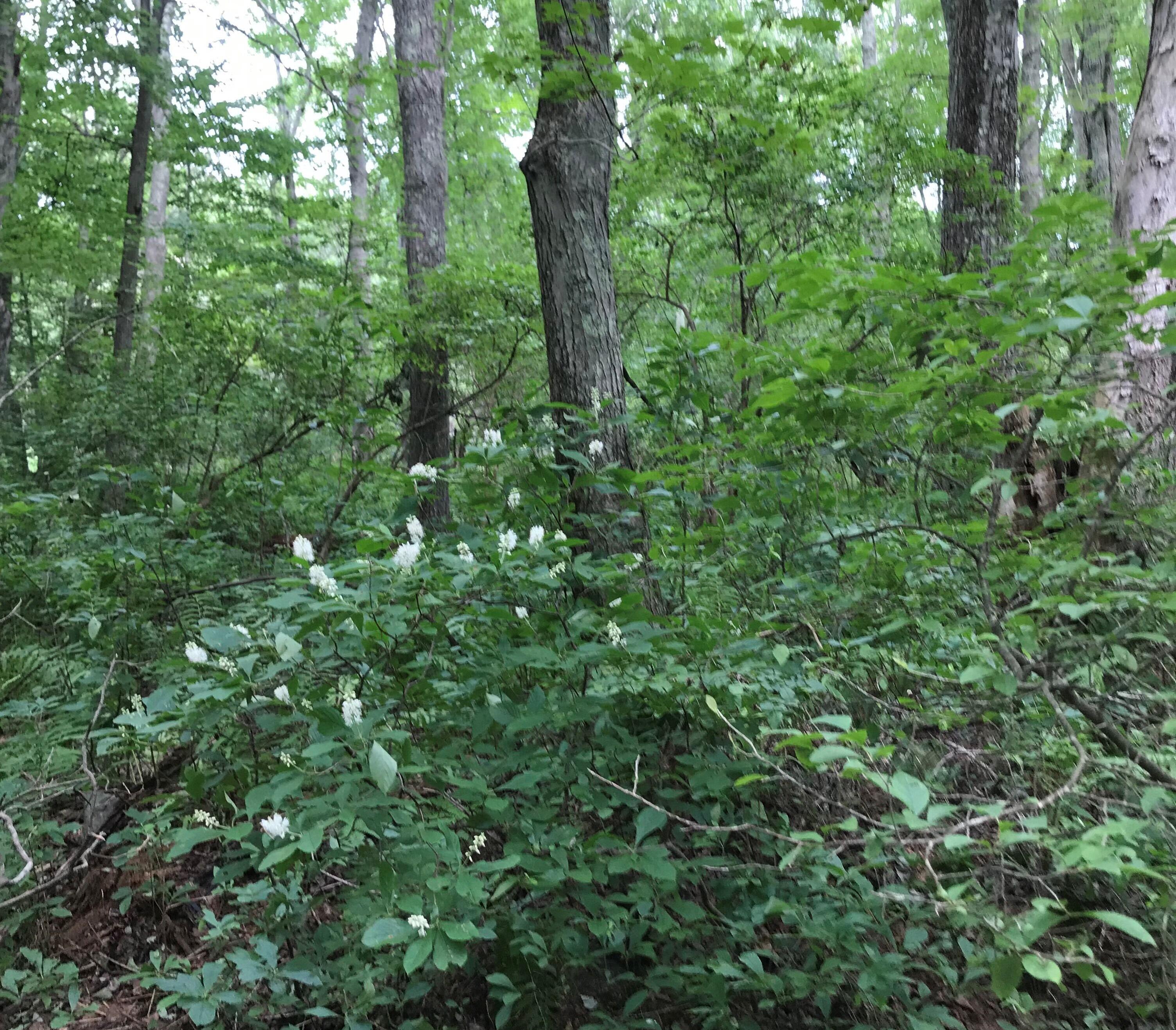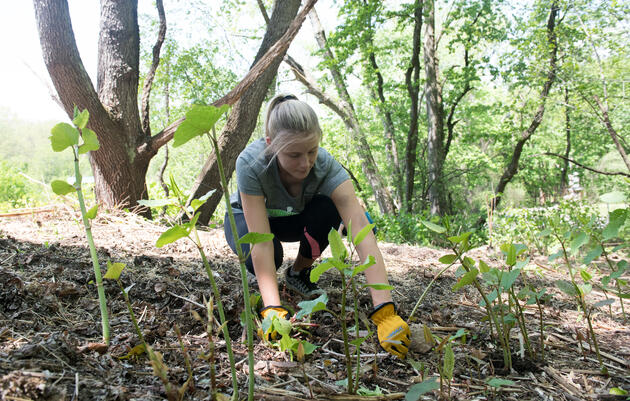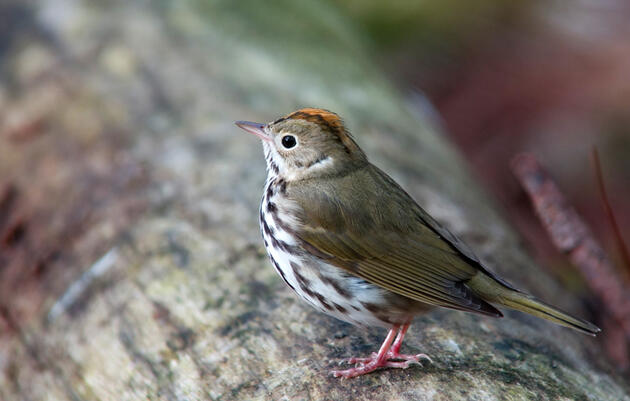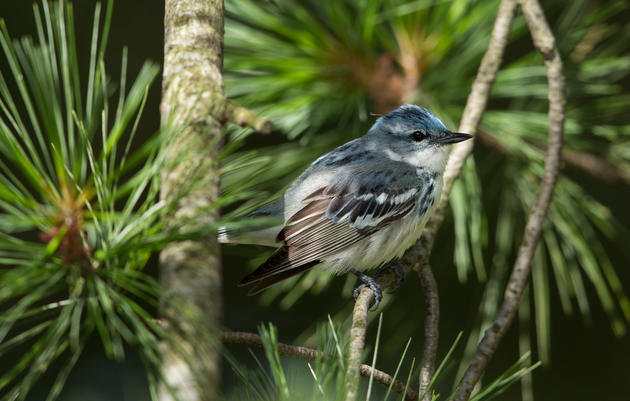“We started our day walking through a forest filled with ferns and winterberry, then looped around through sweet-smelling wetlands where there were tussocks of moss and clumps of sweet pepperbush, which Native Americans were known to use for soap,” recounts Tricia, as if describing a visit to Shakespeare’s fairyland.
“Unfortunately it was the night after a major storm and a generator was running, so we couldn’t hear much bird activity. But once we got far enough away through the wetlands, I heard a rustling in the understory and walked closer to the sound. All of a sudden, an Eastern Towhee appeared, singing, from a branch just a few feet away! It was the pinnacle of the day.”
Tricia Allen is an an Audubon bird habitat assessment volunteer who met Diba Khan-Bureau at Diba’s property that day to conduct what they both expected would be an hour-long assessment and bird survey, as part of Audubon Connecticut’s Lyme Forest Block Project. Diba is also a bird habitat assessment volunteer herself, but welcomed the fresh perspective.
“Three hours later, I was amazed!” cries Diba, “I couldn’t believe the diversity in my 6.5 acres. We identified four different fern species, summersweet, shagbark hickory… There were lots of things I learned that day – most importantly, it was the first time I had ever looked at my property as bird habitat.”
The Lyme Forest Block Conservation Project launched as a dedicated effort to engage people in the stewardship of a critical 1,200-acre area in and around the Lyme Forest Block IBA and protect declining forest bird species.
Before they met, Diba and Tricia both participated in an online training series (see all links at bottom) conducted by Audubon Connecticut, in an effort to teach volunteers how to complete bird habitat assessments, and for landowners to receive recommendations for improving habitat to benefit birds, other wildlife, and forest ecosystems as a whole.
“I bought this land 30 years ago,” explains Diba. “I needed a big enough piece of property because I had horses. Now that the horses are no longer here, the property has changed! At one time there were certain bird species and now I have a different set because the open areas are regenerating with oak and different lower and mid-story trees.”
“Going out with Tricia really opened my eyes to the importance of actively managing my land so it has a diversity of plants, trees, openings in the canopy, snags, and other habitat features that benefit forest birds and other wildlife.”

Before the pandemic, the full-day in-person training was planned to be held in April for the habitat assessment volunteers. However, in the wake of COVID-19, the training program was redesigned to be a four-part webinar series led by a team of Audubon staff and land management experts. As it turned out, there were unexpected positives to the shift.
“I had just finished a book called Braiding Sweetgrass, which made me want to find more ways to help the Earth heal,” says Tricia. “I was looking for a way to get involved, and when I saw the webinars I thought maybe it was a way I could be of help, even from home.”
So what are the outcomes for Diba and Tricia—and birds? “I think Diba felt inspired. She thought the infestation of invasive plants was worse than it was,” says Tricia. “There are so many healthy ferns, birches, beeches, small flowering plants, I think she felt joy and motivation to continue the work at a reasonable level to support the birds. It can be really paralyzing if you think there’s too much to handle, but any landowner can take small steps to make a big difference.”
“Come fall or winter, I’m definitely going to try and get some of the barberry out so I don’t do it in a time when I disturb the birds. I’m going to prune a wild apple tree, which still has apples but it’s not a happy tree,” says Diba. “It’s fun!”
For participating in the project, Diba will receive a plaque and a certificate. “I hope it will make the neighbors take notice and ask questions, and gain some energy around it,” says Tricia.
For those looking to find solace in nature and spend time outdoors, the trainings have offered a way to get involved, learn new things, and be a part of something bigger. Something that creates magical moments.
“I’ve seen all kinds of birds here—Scarlet Tanagers, Pileated Woodpeckers, Red-breasted Grosbeaks, Indigo Buntings, every owl you can imagine!” says Diba. “I was running up my driveway once and, I don’t know what made me look up, but a Snowy Owl was flying overhead. It’s all possible because of the incredible forest habitat that surrounds me.”
Want to watch Audubon Connecticut's Lyme Forest Block training series on your own time?
Video 1: Why Manage Our Woods for Birds and the Birds of Our Woods
Video 2: Trees and Shrubs That Benefit Birds, and What Are 'Invasive Plants'?
Video 3: The Principles of Managing Woodlands for Birds and Understanding Landscape Context
Video 4: Conducting a Habitat Assessment







